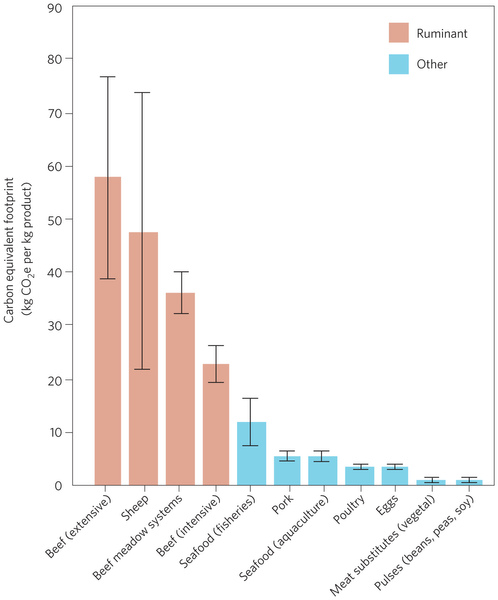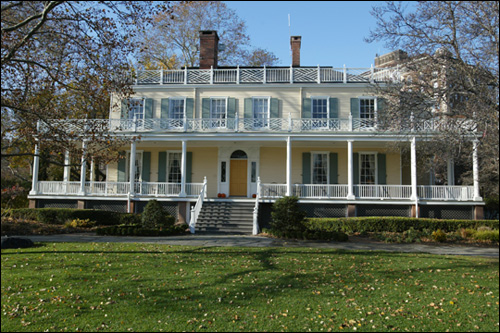In what may be the worst article I ever read (not in terms of scientific quality, but in terms of making me a sad clown), eating certain types of meat causes 15% of climate change. Unfortunately, you, reader, do not have access to the full article, so I will pull some of the quotes from it.
"Worldwide, the livestock sector is responsible for approximately 14.5% of all anthropogenic greenhouse gas emissions3 (7.1 of 49 Gt CO2e yr−1)." 5.7Gt of this is from ruminants, animals that have more than one stomach and chew their cud (about 4.6Gt from cows, .6Gt from buffalo, and .5Gt from sheep and goats). 1.4Gt are from monogastric, ie single stomached, animals: pigs, chicken.
Why do ruminants produce so much? Cause they belch methane. On a 20 year timescale Methane is 75 times more powerful a greenhouse gas than CO2. And why is this? We've discussed this before, but it is worth revisiting.
The Science of Heat-Trapping Gases (skip this part if you don't like science)
(Any atmospheric chemists reading this: I apologizes for bastardizing the science a little bit, but this is meant for a general audience, so I will gloss over details and simplify some concepts)

Electromagnetic Spectrum! (source)
First, let's revisit the idea of radiance. Everything gives off light. It's not light like we normally consider it, as in what we can see. Instead it is all sorts of light we can't see, either. Like infrared, UV, and even x-rays. You've heard of the electromagnetic spectrum. It's the picture above. Visible light is only a tiny fraction of it.
So. Again, everything gives off light. The wavelengths of light an object gives off is based on its surface temperature. Humans give off a characteristic light at around 35C, cause that is roughly our body temperature. This is just a small part of the infrared. The Earth absorbs the light that the sun gives off, warms up, and then emits its own light based on surface temperature. And this light it emits? It is heat. It is the planet/sun/person losing its heat energy.
And that light it gives off is in the range shown in the picture below.
Image from UCAR. Look at CO2, and then look at the region around 8.
The image above tells the whole story. Consider the drop in the line to be absorption %. In other words, a sharp dip in the line indicates that compound is re-absorbing the light that Earth gives off, trapping it in the atmosphere. If you look at the CO2 band between 4 and 5, and then the higher CO2 band, you see that it pretty much is absorbs all the light. If you look around 8, where methane absorbs, you see that it is pretty much wide open. So every bit of increase in methane is fully effective at trapping more heat emitted from Earth.
"But Jason," you say, "If CO2 absorbs pretty much all the light in it's region, how does more CO2 increase how much heat it traps?" Well, my friend, you ask an excellent question. You know the Doppler effect? The one where an ambulance siren sounds differently coming towards you than it does when it goes away? That is because the vehicle is traveling an appreciable % of the speed of sound, so it slightly compresses the sound waves when it comes towards you (the ambulance sort of is trying to keep up with sound waves, so it emits subsequent waves closer to each other) and spreads those waves out when it is moving away from you (the ambulance is kind of trying to move ahead of each sound wave it emits, so a little extra space is between wave peaks). Your ear interprets the pitch of sound based the distance between these wave peaks.
How the heck does this relate to CO2? Well, this doppler effect occurs in light absorption as well, mostly related to effects based on the distribution of temperatures in a set of molecules. There are many different types of effects with light absorption that can act similarly, and they are together referred to as Broadening Effects. They are called this because they smear out the absorption region. So, more CO2 in the atmosphere, more broadening of the light absorption. In other words, CO2 absorption expands out sideways in that picture of light absorption, which is less efficient than expanding directly down, like CH4 does.
Back to the Meat!

CO2 equivalent emissions from various types of meat.
From Ripple, W, et al (2014). Ruminants, climate change and climate policy. Nature Climate Change.
Briefly, ruminants produce a lot of CO2 per kg of meat. The above chart compares them all. Stick with poultry and pork.
Cow alone contribute nearly 10% of anthropogenic greenhouse gas emissions. There are 1.4 billions cows in the world. About 20 million get added per year. That's pretty much a cow for every first-world citizen. Now, I'm a die-hard carnivore, but that sounds like a lot.
Now that I've spent a ton of space on describing methane, let's talk about some other causes of emissions from cows. With 20 million more cows needing places to eat and live per year, there is massive deforestation. Cows also tend to destroy environments, making it difficult to grow stuff there later. In some cases, it rapidly converts land to desert. But watch this video where a guy talks about how managed livestock movements can actually reverse desertification.
Okay, back on point. We apparently eat too much cow. Well, we eat too much in general. I am sure that the people eating too much in general are also eating too much cow.
Scary point: I recently read that the amount of extra food that went into making our world's obese could feed 300 million people for life. In other words. nearly half of world starvation could be completely fixed if a bunch of us weren't overeating. And we'd be a good chunk closer to stopping climate change.
Shorter version: next time some vegan tells you that eating meat causes 15% of climate change, first, agree with them. Then let them know that it is mostly from people over-eating cow, and that since you eat mostly chicken and pork, they should bring their complaints somewhere else.
On a more serious note, I do not like admitting the reality of cow being bad for the environment. I love eating cow. I make smoked meat. But we need to trust the numbers and be impartial towards these things. So I make mostly smoked pulled pork and pork ribs. And I eat a ton of chicken.
thanks for reading!
- Jason Munster








